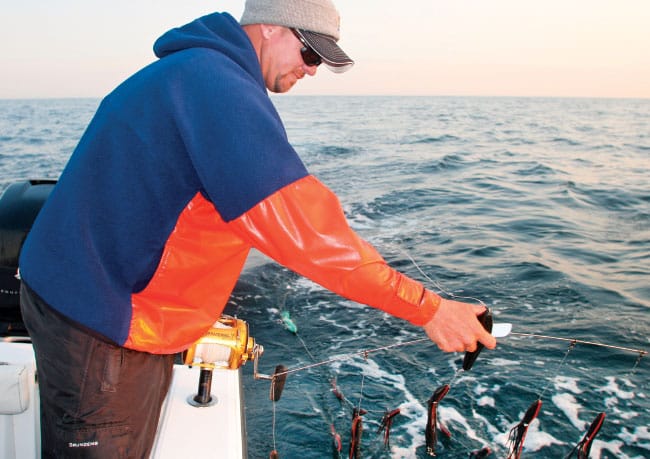
Teasers
“In my singular opinion, you can’t hook a fish unless you’ve first gotten its attention. You’ve got to tease that fish.” So says Dennis Braid, legendary big-game angler, former world-record holder and founder of Braid Products.
His point is worth noting. Knowledge of teasing fish in the offshore world is a necessary precursor for success. But mastering teasing tactics is only part of the equation. Just as important — and interesting, for that matter — is having a broad understanding of the actual teasers themselves. Through the years, lure manufacturers and fisher-men have developed several different styles, and each plays an important role in an angler’s arsenal.
The Daisy Chain: In-Line Action
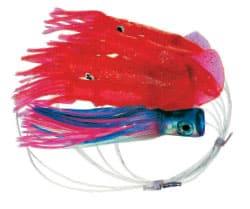
| |Mold Craft’s popular Tropic Star Daisy Chain features 9-inch squids trailed by a Standard Super Chugger.|
While single, hookless natural baits and lures are often used effectively as offshore teasers, perhaps the most common type is the multiple-bait daisy chain.
An in-line grouping of soft-plastic teasers spaced apart on heavy monofilament, a daisy chain often stretches 10 feet or more in length. Its soft, hookless teasers are usually (though not always) designed to mimic squid, and when trolled through the water, these teasers skip and splash seductively in the boat’s wake, sometimes drawing fish in from great distances.
“Anglers argue a bit about what exactly a fish believes a daisy chain to be,” says Dave Adams, founder and chief executive of Tormentor Tackle, which makes a wide variety of offshore teasers, “but it could simply be a school of small fish or a small predator chasing a school of prey.”
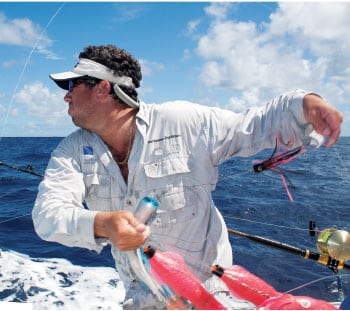
| |Puerto Rico’s Capt. Omar Orraca tosses out a big daisy chain, hoping to draw in a blue marlin. (MIKE MAZUR)|
For that latter reason, Adams likes to rig a larger “hook bait” on the end of his chains, often one that looks like a small peanut dolphin or little tuna that’s chasing the squid teasers.
Frank W. Johnson III, vice president and general manager at Mold Craft Products, agrees. “When a daisy chain is used with a hook bait,” he says, “we like to use an alternate bait, something different than the leading baits — either a slightly different color of the same style or a completely different style. We frequently use either our Super Chugger or a Spooler as the hook bait. We also increase the distance of the spacing on the last bait by at least one-and-a-half or two times the regular spacing to give it the appearance of a straggler.”
Why? Stragglers appear weak and make easy pickin’s for game fish.
Spreading It Out
Similar to daisy chains, spreader bars also ride on the water’s surface and are designed for the troll. But instead of comprising a single string of in-line baits, a bar employs a wide grouping of staggered soft-plastic baits.
“A spreader bar usually has a flexible wire rod rigged at a 90-degree angle to your leader at or near your snap swivel,” says Adams. “This rod has places to attach a main leader down the center, and it usually has places to attach two teaser lines on either side of the main leader.”
The main, centerline leader runs far back and is designed for a single hook bait. The teaser lines on each side are shorter and might hold several soft-plastic hookless teasers. When pulled, the entire bar looks like a pod of bait skipping through the water, usually with a straggler lagging behind.
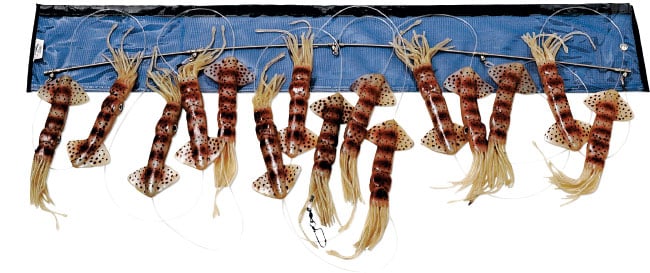
| |The baits on Williamson’s Live Squid Spreader Bar look almost good enough to eat!|
Of course, bars (and daisy chains, for that matter) are often used solely as teasers, meaning no hook baits are attached. In such cases, outrigger lines with natural baits or lures are often strategically placed just behind the bar or chain; pitch baits are also often tossed back to hungry predators that rise to investigate the commotion.
And sometimes, bars and chains are actually adorned with natural baits, instead of plastic teasers. This also holds true for the next type of offshore teaser: the dredge.
Subsurface Teasing
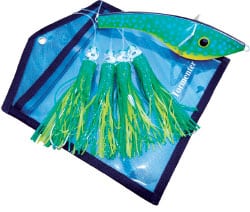
| |Tormentor Bird/Bone Head Stinger Chain|
Dredges are basically clusters of either hookless soft plastics or natural baits designed to mimic a baitball. They’re generally slow-trolled below the water’s surface, typically held down by in-line trolling sinkers.
Dredges have become extremely popular, especially in some of the mid-Atlantic billfish events, where Adams says the teasers might be rigged with as many as 70 natural baits each. “They’re taking our $22 Dredge Witches and placing them in front of each natural bait,” he says. “They’ll have invested $1,000 into each dredge, and they drag four simultaneously. They rig enough dredges to be able to change them out every four hours, not counting losses to cutoffs when backing down on a fish. I am certain they have figured out that it is worth doing.”
Of course, most of these dredge applications use natural baits, but elongated soft-plastic stick-style baits can be very effective in their own right when incorporated into a dredge, says Mike Hogan, owner of the Hogy Lure Company. “They’re getting pretty popular,” he says. “There are no tails to vibrate off during a day of trolling.”
And that translates into a much more affordable fishing experience.
The Big Guns
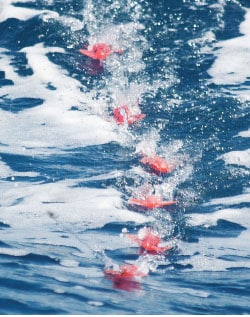
But dredges, daisy chains and spreader bars are just the beginning of the offshore-teaser repertoire. Large splash teasers, such as birds, are often pulled behind a boat, sometimes by themselves and other times in conjunction with different types of teasers, such as bars or chains.
“The term ‘bird’ is a bit of a misnomer,” explains Johnson, whose company manufacturers three different sizes of birds with wingspans of 3, 4 and 6 inches. “It is not intended to mimic a bird; it’s more intended to mimic a baitfish, particularly a flyingfish as it begins to evade a predator.”
Tormentor’s Bowling Pins, especially the large, 13-inch model, can also be dragged by themselves or with chains and bars, and are meant to mimic a tuna or dolphin feeding at the surface.
Then there are large teasers that are pulled in the wash directly from the transom. The diving, darting action of Mold Craft’s Fish Fenders — which are actually made from boat fenders — simulate a feeding tuna that plunges down some 10 feet below the surface. Similarly, Braid’s Dorado Teaser is a 4-pound mirrored plug that emits tremendous vibration in the water
“We rig them on 500-pound mono with four feet of 480-pound cable,” says Braid. “The tow line is only about 30 feet long. You don’t need it too far back in the spread. They’re just designed to get the fish’s attention and keep its attention.”
Just like a good teaser should.
How Much is Enough?
So how many teasers in the spread are enough? That’s a debate that could go on forever (and has gone on forever), but Frank W. Johnson III, vice president and general manager of Mold Craft Products, offers some advice that’s as good as any: “The real question here is how much tackle can your anglers and crew manage without getting tangled, while still maintaining the ability to easily clear lines when a fish is caught?”
Brain Teasers
Black Bart Lures
Riviera Beach, Florida
866-289-7050
blackbartlures.com
Boone
Fishing Tackle
Winter Park, Florida
407-975-8775
boonebait.com
Braid Products
Palmdale, California
661-266-9791
braidproducts.com
Hogy Lures
Falmouth, Massachusetts
508-444-8764
hogylures.com
Mold Craft Products
Pompano Beach, Florida
954-785-4650
moldcraftproducts.com
Normark Corp.
(Williamson Lures)
Minnetonka, Minnesota
952-933-7060
rapala.com
Tormentor Tackle
Riviera Beach, Florida
561-844-6800
tormentortackle.com
Tournament Cable
Burleigh, New Jersey
800-979-3474
tournamentcable.com








